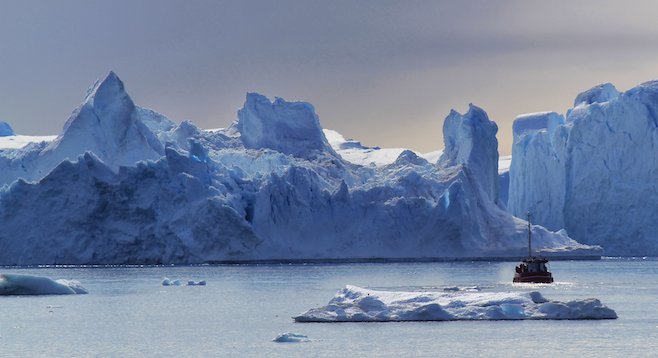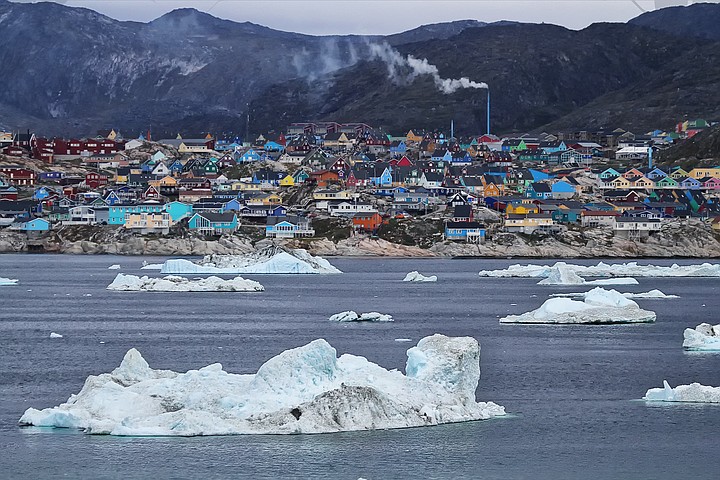 Facebook
Facebook
 X
X
 Instagram
Instagram
 TikTok
TikTok
 Youtube
Youtube

I looked out the window of the plane as it approached the southeast end of Greenland at twenty-odd thousand feet and was happy to see the cloud cover was clearing.
I could see the coastline as we crossed the country heading to Kangerlussuaq and the ex-American airfield where I was to meet my ship. It had taken four planes and too many uncomfortable hours of economy seating to get to where I would board the small cruise ship for two weeks of Arctic scenery and wildlife.
In the past I've seen glaciers in Alaska, Canada, Montana, Chile and New Zealand, but looking down I could see that this place was different. The entire land mass was covered by ice cap, with glacier pouring over the sides like icing on a cake. The cap itself was dotted with lakes of various sizes in incredible shades of blue where the surface melting took place. The surrounding sea was filled with icebergs, which could be seen from so high up.

Imagine the largest island in the world, three times the size of Texas, with a population a little less than the city of Encinitas. About 80% of the people are native Inuit making a subsistence living, with the rest mostly Danes working in other areas of the economy.
The other inhabitants of Greenland are the ones you see on Animal Planet and PBS Nature: the polar bears, foxes, birds and musk oxen. Also the whales, dolphin and seals that live in the surrounding sea. We saw them all in two weeks, the most memorable being the dozen or so polar bears roaming their natural habitat.
But the most striking impression I took away was of the ice, thousands of glaciers funneling icebergs in all shapes and sizes into the sea. Some were the size of ships, some the size of skyscrapers floating on their sides. Some were small and scattered across the surface of the sea like crumbs on a plate. How to describe the mesmerizing ice we saw every day as we motored and drifted around them in zodiacs? Can't be done – it's a sight like no other.
So while some continue to debate man's connection with climate change, most acknowledge that temperatures are rising, and it's most evident here in Greenland. As to whether or not it applies to us, the Inuit have a saying: "Only the weather and ice will decide."
If you go, you'll see what they mean.


I looked out the window of the plane as it approached the southeast end of Greenland at twenty-odd thousand feet and was happy to see the cloud cover was clearing.
I could see the coastline as we crossed the country heading to Kangerlussuaq and the ex-American airfield where I was to meet my ship. It had taken four planes and too many uncomfortable hours of economy seating to get to where I would board the small cruise ship for two weeks of Arctic scenery and wildlife.
In the past I've seen glaciers in Alaska, Canada, Montana, Chile and New Zealand, but looking down I could see that this place was different. The entire land mass was covered by ice cap, with glacier pouring over the sides like icing on a cake. The cap itself was dotted with lakes of various sizes in incredible shades of blue where the surface melting took place. The surrounding sea was filled with icebergs, which could be seen from so high up.

Imagine the largest island in the world, three times the size of Texas, with a population a little less than the city of Encinitas. About 80% of the people are native Inuit making a subsistence living, with the rest mostly Danes working in other areas of the economy.
The other inhabitants of Greenland are the ones you see on Animal Planet and PBS Nature: the polar bears, foxes, birds and musk oxen. Also the whales, dolphin and seals that live in the surrounding sea. We saw them all in two weeks, the most memorable being the dozen or so polar bears roaming their natural habitat.
But the most striking impression I took away was of the ice, thousands of glaciers funneling icebergs in all shapes and sizes into the sea. Some were the size of ships, some the size of skyscrapers floating on their sides. Some were small and scattered across the surface of the sea like crumbs on a plate. How to describe the mesmerizing ice we saw every day as we motored and drifted around them in zodiacs? Can't be done – it's a sight like no other.
So while some continue to debate man's connection with climate change, most acknowledge that temperatures are rising, and it's most evident here in Greenland. As to whether or not it applies to us, the Inuit have a saying: "Only the weather and ice will decide."
If you go, you'll see what they mean.
Comments